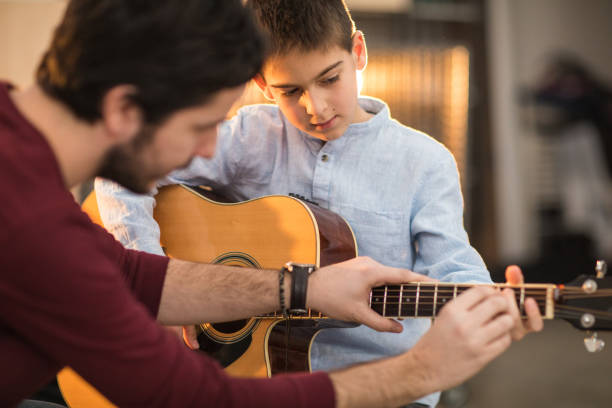
How to Play Guitar for Beginners
Are you ready to begin with chords and play some tunes on six-stringed instruments? Teaching how to play guitar for beginners may be fun. Whether you will play to become the next Pete Townsend or just be able to play your favorite tunes without embarrassing yourself, the guide will let you start on the right track.

It is one of the most favorite subjects, and thousands of people with different backgrounds have some sort of connection to it. Before going any further, however, it would be a good time to go over some of the most well-known guitars. Guitar performs from nice and mild acoustics in the romantic context to an aggressive grinding solo in the next. However, nobody is going to start singing like Jimi Hendrix or strumming the guitar like Tommy Emmanuel.
Below is a complete manual on how to play guitar for beginners—more than you will ever find on the internet. In this lesson, you will learn how to choose your first guitar and get an overview of the labels that refer to the parts of the guitar, as well as some fundamental guitar chords and practices to initiate your practice.
Choosing Your First Guitar
The first ingredient anyone requires before one can start aspiring to learn how to play guitar for beginners is a guitar. Here are some tips for choosing your first guitar:
Acoustic or Electric:
The two major decisions that the consumer will come across will be whether to go for an acoustic guitar or an electric guitar before proceeding to lessons. Acoustic guitars are especially good for a beginner to learn to play since there are no requirements from the players for other apparatus like an amplifier.
Size Matters:
Ensure that the guitar answers to your physique appropriately. Full size is usually satisfactory for many newcomers to choose from; however, there are mini kinds if necessary.
Budget:
Set a realistic budget. It is not necessary to overspend, but try not to buy very low-quality instruments that will affect your learning process.
Try Before You Buy:
You should try to go to a music store and start to feel various guitars with your hands.
Learning About the Different Sections of the Guitar
- Headstock: This is where the strings are attached on the pegs to help rest it again as required.
- Neck: The large portion of the guitar on which fingers will be placed to create chords, I think.
- Fretboard: It is a flat surface on the neck with the metal frets The.
- Body: The largest body part of the guitar, which is concave in acoustic guitars.
- Strings: A musical instrument consisting of six high-tensile strength metal strings for music-making, by either being plucked or strummed.
- Sound Hole (on acoustic guitars): The hollow, round shape that produces sound in front of the listeners.
- Bridge: The fixed of the strings to the body of the guitar.
Tuning Your Guitar
Tuning your guitar before you start to play is very important. The most common tuning for a six-string guitar is EADGBE. I list them starting with the firmest string to the thinnest one. By buying a digital tuner or downloading the tuning application for your smartphone, you will easily get the right pitch for your strings if you are a beginner trying to learn how to play the guitar.
Basic Chords for Beginners
A Major:
Put your first finger on the 2nd fret of B, your 2nd finger on the 2nd fret of G, and the third finger on the 2nd fret of the D string.
D Major:
Put your index finger on the second fret of the G and B strings, your ring finger on the third fret of the second B, and your central finger on the second fret of the first E.
G Major:
Spending your third finger, put it on the 3rd fret of the low e string; your second finger is placed on the second fret of the A string; and your fourth finger is on the third fret of the high E string.
When practicing these transitions, begin slowly, and as you progress with time, try doing it faster.
Strumming Patterns
The strumming is one of the most vital things for any person to learn when he is mastering how to play guitar for beginners. Begin with playing the downstream for each count quite easily. As you get comfortable playing bar chords, try using down-strum and up-strum techniques to create distinct rhythms.
Reading Guitar Tabs
Several forms of music notation have been designed in such a way to play a guitar; however, the most common method is called guitar tabs, or tabs. It depicts numbers on 6 horizontal lines; each of the lines represents stings and tells you where to put your fingers to fret. It will also make you able to play your favorite songs faster in case you learn how to read tabs.
Fingerpicking Basics
After, you have mastered chords and strumming into your system; you may wish to consider fingerpicking. This technique includes using the fingers to pick distinct strings in a song instead of using a pick to do that. Begin with the thumb on the bottom three strings and the index, central, and ring finger on the top three strings.
Practice Tips for Beginners
- Set a Schedule: Ideally, one should practice for about 15-30 minutes daily, but one has to understand your mileage will vary depending on the circumstances you’re in.
- Start Slow: Do not memorize the chords or techniques as fast as you can; try to memorize them right to the point.
- Use a metronome: This will help you keep time and vibrate the way you wish to be always vibrating or swaying.
- Teach Songs You Love: The kind of music played will make you motivated so that you can have fun as well.
- Don’t Overdo It: It is also important from time to time to avoid hand tiredness as well as to keep the spirit high.
This section outlines some of the relatively frequent issues that learners face, especially when they are starting.
- Sore Fingertips: This is normal and will reduce with time as you gain calluses, which are the dead layers of skin that you build when pulling. Be persistent with it, but do not get stressed if it is too hard; simply get a break.
- Difficult Chord Transitions: Perhaps it will take some time for the consumer to learn to switch between two chords; regularly use this as a guideline.
- Buzzing Strings: Be sure to apply the pressure on the string actually at the back of the fret so that you can bend it.
Continuing Your Guitar Learning
As you progress in your journey of learning how to play guitar for beginners, consider these next steps:
- Learn Barre Chords: These chords involve the use of the index finger in order to depress more than one string simultaneously.
- Explore Different Genres: You could arrange to play different styles of music to expand your repertoire of musical styles.
- Jam with Others: Using accompaniment means a better distinct timing as well as opening new horizons in musical perception.
- Take Lessons: Continue practicing, but you might want to get instructions from an expert just in case you wish to upgrade your skills in this game.
Conclusion about How to Play Guitar for Beginners
Learning how to play guitar for beginners is an interesting and satisfying process. Recall, that no mastering guitarist has started with being an experienced one. It is not rocket science, and once you can spare time, learn how to familiarize your fingers with the strings, and then you will be rewarding yourself with the tasty chords.

Do not despair if initially, the process seems to be moving at a glacial pace—but that is part of the learning curve. Stick to it, and, in no time, you will be showing your friends and family your guitar-slinging prowess.
So grab your guitar and get on with the chord learning and playing and a lot of musical fun awaits you. Who knows? You could be the next guitar hero in the making, literally!
FAQs about How to Play Guitar for Beginners
In how many ways can one learn to play the guitar for beginners? Can one acquire the skills for using the content?
Learning guitar time differs from one person to the other. New guitar players should practice 15–30 minutes daily, and using these tips, most students can learn simple songs within the first few months. But the mastery of the instrument takes a good number of years of practice.
Am I right in thinking that long nails are needed to play a guitar well?
Yes, for the record, you do not require long fingernails to play guitar. One should avoid growing long nails on your fretting hand, which is commonly on the left hand for right-handed guitarists because doing so will make it difficult to put pressure on the strings required, especially when bent. Some players may have nails long on their picking hand, but one doesn’t have to do that; it’s a matter of preference.
Click this link to access the GuitarTricks.com Free Trial page >>
Click here to access the GuitarTricks.com Free Trial >>
Leave a Reply